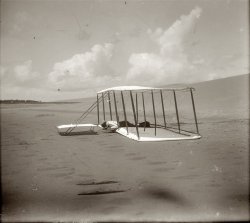
MAY CONTAIN NUTS

Search Shorpy
SHORPY ART

Framed or unframed, desk size to sofa size, printed by us in Arizona and Alabama since 2007. Explore now.
Join and Share
Ad-Free Shorpy
Shorpy is funded by you. Patreon contributors get an ad-free experience.
Learn more.

Recent comments
- Freeze Frame
- Texas Flyer wanted
- Just a Year Too Soon
- WWII -- Replacing men with women at the railroad crossing.
- Yes, Icing
- You kids drive me nuts!
- NOT An Easy Job
- I wonder
- Just add window boxes
- Icing Platform?
- Indiana Harbor Belt abides
- Freezing haze
- Corrections (for those who care)
- C&NW at Nelson
- Fallen Flags
- A dangerous job made worse
- Water Stop
- Passenger trains have right of way over freights?
- Coal
- Never ceases to amaze me.
- Still chuggin' (in model form)
- Great shot
- Westerly Breeze
- For the men, a trapeze
- Tickled
- Sense of loneliness ...
- 2 cents
- Charm City
- What an Outrage
- Brighton Park
Member Photos
The Shorpy
Print Emporium
Print Emporium
Search Shorpy
Search results -- 30 results per page
- Tourist Class: 1906
- "Unloading cattle from ocean steamer Julia ." Traveling steerage circa 1906. 8x10 inch dry plate ... Posted by Dave - 07/29/2012 - 1:30pm -
![Tourist Class: 1906 "Unloading cattle from ocean steamer Julia." Traveling steerage circa 1906. 8x10 inch dry plate glass negative, Detroit Publishing Company. View full size.
BleedingThis picture wounds my heart.
So inclinedI changed my mind, I want to use the ramp!
I wonder if Bessiewas offered a cardboard framed copy of this photo in the lobby.
Bovine Necktie PartyYup, there’s more than a few meatpacking borons in Chicago who would like to have seen Upton Sinclair in the same position.
["Borons"? - Dave]
Ops, didn’t have coffee yet before commenting. I should know better.
["Ops"? - Dave]
The dog ate my homework?
Maybe, just maybethey are trying to turn the bovine into a giraffe
Dangling Well, there's a graphic example of "Taking the bull by the horns." I would think one might have to be brave and possibly a bit nuts to be around that bull once the rigging comes off of those horns! Operative word should be "RUN!" Great photo.
SteerageHanging by the horns? That's just wrong!
Jurassic Park RememberedMakes me wonder a lot how they lower the cattle without horns.
AkimboIs it possible to get a close up of the fellow on the deck to the right of the cow? He has a panama hat and moustache, an arm akimbo. I'm thinking he is a classic image from that period. Maybe he's Akimbo Tamoroff of Havana.
WWPDWhat would PETA do?
That certainly looks uncomfortable, I wonder if they broke many necks with that rigging?
Sailing Steer's SongYour love is lifting me higher and higher, than I've ever been lifted before.
Now that's a well hung bullSorry, I couldn't think of anything better to say than that.
Hemp candycaneWhat was the reason for the piece of thick rope hanging off the rail just to the cow's left?
High Tech RanchingI sure am glad that livestock survived the industrial revolution and they gave up the more efficient way of handling them!
DominionI suppose it really doesn't matter what a fine specimen of an animal this might be if it's destined for the abattoir - nor the means in which it gets there. We are such cold and unfeeling beings at times.
Back somersault?When I first saw this photo in the thumbnail view, I thought it was a steer doing a back somersault off the side of a ship. Imagine my disappointment when I went to the full size view.
(The Gallery, Animals, Boats & Bridges, DPC)](https://www.shorpy.com/files/images/4a11169a.thumbnail.jpg)
- Five-Milers: 1914
- ... N.Y., won a long, hard 5-mile swim for women in the ocean waters around New York. The race was held under the auspices of the ... Posted by Dave - 08/19/2012 - 5:02pm -
![Five-Milers: 1914 New York, July 16, 1914. "Martha Hogstedt, Elsie Sultan, Edna Cole. Women's race." The top three finishers (from left, 1-2-3) of the National Women's Life Saving League five-mile swim from Rockaway Inlet to Brighton Beach. 5x7 glass negative, George Grantham Bain Collection. View full size.
My Name IsIt's funny how popular names change with the generations. What used to be Martha, Elsie and Edna now becomes Tiffany, Kyra and Caitlin.
Old Spike Milligan Gag"Last night, I went to a French restaurant. The lady at the next table had frog's legs... her friend's were even worse!"
It's Like I Always SayOur ancestors in the first twenty or thirty years of the 20th century were far less prudish than we have been led to believe they were. And indeed far less prudish than many people are today.
But they are wearing them. . .As for not lasting two minutes on an American beach of this time wearing this kind of bathing suit. . .
But but - they ARE wearing them! I've seen other pictures of girls wearing this sort of suit in the 1910s. They are especially revealing because they are wet and suits of that era did not have any support of any kind - so what you saw when they were wet was pretty much what the person's figure was. And these girls are fine and look very strong!
Mothers of the Greatest GenerationI wonder how many kids these girls would eventually have. Would any of them become Gold Star mothers? No way to know, of course, but questions like that come up when you look into the eyes of these candid, unpretentious subjects. And by the way, a shadow on the wall suggests that someone standing to the photographer's right was wearing a fedora!
[That's the photographer. - Dave]
5 Miles?!Wow! Imagine how hard it would be to swim that far wearing a wool bathing suit. They all look to be in fantastic shape.
Scandalous!!For this era, it's incredible how revealing their bathing suits are.
They wouldn't have lasted two minutes on an American beach of the time before being thrown into the hoosegow for indecent exposure.
Unfair AdvantageThe swimmer in the middle appears to have a couple of flotation devices which if Olympic coverage is any indication have long-since been banned from women's competitive swimming.
Fit and TrimI wonder how many women competed in the event and how many years the event lasted. They can save my life anytime.
Ever seen a wet Speedo?They do not have any undergarment support either, and they are just as revealing as the old wool ones, especially the the light blue colored ones. Why do you think so many young men go out for swimming?
Reverence AskewAsymmetry is a defining feature, and perhaps the charm, of the human form.
"I Feel Fine"
Young Women Who in Swimming Race Covered a Five-Mile Course in Atlantic; The Victory of Little Miss Hagstedt Was a Surprise to Experts in Aquatic Sports
Amid mingled exclamations of astonishment and surprise by expert swimmers stationed at the finish, Miss Martha Hagstedt, of Brooklyn, N.Y., won a long, hard 5-mile swim for women in the ocean waters around New York. The race was held under the auspices of the National Women's Life-saving League. The winner's time was 1 h. 32 m. 31 2-5s. Miss Elsie Saltan, finished in 1 h. 33m. 46 3-5s., and Edna Cole was third, in 1 h. 37m 24 1-5s. Ten girls competed. Besides those who won the prizes, there were Mrs. Lillian Howard, Miss Lillie Bartildes, Miss Rita Greenfield, Miss Clarabelle Barrett, Miss Ethel Strauss, Miss Sophie Freitag, and Miss Anita Dryer. Of the big field Mrs. Howard and Miss Cole were the favorites with the swimming handicappers, and when Miss Hagstedt, who is much smaller and built on less generous lines, beat them both she gave them a severe shock. When asked how she felt, Miss Hagstedt replied: "I feel fine. I don't feel a bit tired. I feel so good that I could start in another race." Miss Hagstedt, who is 20 years of age, and weighs 125 pounds, had to fight every inch of the distance to secure first prize.
Washington Post, Jun 19, 1914
Remarkable Progress Made by Women in All Lines of Outdoor Sports Since Grandma Sat Around and Knitted
The recent remarkable exhibitions of swimming and diving by young women contestants at the New York sportsmen's show, held in Madison Square Garden, directs renewed attention to the increasing efficiency of women athletes in all branches of outdoor sports.
Here was indeed a significant spectacle — a score of fine, modest, well-bred girls — carrying off swimming and diving honors before mixed audiences of tens of thousands during the week from January 2 to January 9, and doing it with as much confidence and absence of embarrassment as if they were so many professionals of the sterner sex.
...
Although amateur athletes, these girls are so proficient in swimming and diving, and all water sports, that they actually vie in records with the best professionals, like Annette Kellerman, who offered the diving trophy. It does not shock them at all that their photographs and names are frequently printed in the newspapers in connection with their athletic triumphs. Such names as Elsie Hanneman, winner of the world's woman's fancy diving championship; Nellie Greenhall, who though barely 16 years old, swims 100 yards in 1 minute 5 ½ seconds; Miss M. Simpson, Miss Edna Cole, Miss Millie Bartildes, and among scores of others, the Misses Josephine Bartlett, Lucy Freeman, Rita Greenfield, Mary Nerich, Martha Hogstedt and Elsie Sutton.
At their age grandmamma, tenderly shielded from any contact with the outside world, was doing her "tatting." Her athletic pretentions were limited to a ladylike game of croquet on the home lawn, well screened from the public.
If grandmamma is amazed at the change that has come over girls in the last 40 years, what amazes her most, probably, is that the higher the social scale the more addicted are its girls to strenuous outdoor sports. Grandmamma might expect that sort of thing in the case of "hoydens of the working classes," show hard-working parents have no time in which to "properly bring them up," but not in the case of the daughters of parents possessing wealth and inherited refinement.
...
Washington Post, Jan 17, 1915
"Built on less generous lines"What a great turn of phrase.
(The Gallery, G.G. Bain, NYC, Sports, Swimming)](https://www.shorpy.com/files/images/16602u.thumbnail.jpg)
- Boston Harbor: 1906
- ... but did not sink. In WWI, the H.M. Whitney was sold for ocean service. She seems to have been renamed the Maria Pinango in 1923 and in ... Posted by Dave - 07/28/2012 - 4:38pm -
![Boston Harbor: 1906 Boston, Massachusetts, circa 1906. "Boston Harbor and waterfront." Panorama of two 8x10 inch glass negatives, Detroit Publishing Company. View full size.
The Waning Days of SailThe three ships with 5 masts each out in the harbor must be Cape Horners. Around the turn of the twentieth century, these enormous ships were constructed to be the fastest to Asia (before the Panama Canal), their speed outstripping even the storied "clipper ships."
Day-OThe smokestack with the diamond (left side of picture)is a United Fruit Company, now Chiquita Brands, "banana boat."
What's the island in the background?Pretty sure this was taken from Old Harbor South Boston making the samll island in the background Western Way or Thompson Island.
Incredible ChangeThere are very few things extant in this photo. The Custom House Block building is still there as is the three story building to its left. Yet beyond that it is near unrecognizable. The end of Long Wharf was the rented Boston Immigration Station now a open public pavillion. Central Wharf, which says Mellin's Food for Infants and Invalids is now home to the New England Aquarium.
The islands of the inner harbor can still be seen here. On the horizon from right to left there are many now lost landmarks. At the farthest right is Deer Island and the Suffolk County House of Correction which stood from 1880-1991). Next in the foreground is Governor's Island (with all those prominent trees) which was destroyed with Apple Island with the building of Logan International Airport. Apple is the thinnest mark almost lost in the masts of the white ships. The town of Winthrop is the rise above Apple with well built up Breed's Island to it's left. Part of Breed's became part of Logan and the rest were fused to East Boston.
Philadelphia SteaPhiladelphia Stea? (just to the left of the big black ship funnel in the left/center foreground):
Steaks
Steam
Steamers
Steamships
Steamship Company
Steamship Company Ltd.
BTW, who is piloting that rail barge a few yards from the dock in open water??
[Boston and] Philadelphia Stea[mship Line]Most likely "Philadelphia Steamship" or "Philadelphia Steamship Line," from the Boston and Philadelphia Steamship Company.
Agent: Francis P. Wing
Reference 1
Reference 2
Reference 3 (PDF)
Hard work and leisureFrom a European point of view, even big schooners were coasters rather than Cape Horners. The latter tended to be the domain of square-riggers (such as the Flying P-liners).
Anyway, those two pretty little steam yachts to the right make a nice contrast to the brawny cargo haulers.
Five-Masted Coal SchoonersBy 1900 few if any East Coast sailing ships were still engaged in the China Trade. Pacific Coast steamships and the Transcontinental Railroad had taken over most of that commerce as early as the 1870s. The great five-masted schooners seen here, all more than 300 feet in length, were mostly built in Maine beginning in the late 1890s to deliver coal to Boston and other East Coast ports. Some remained in service into the 1930s. Similar Pacific Coast schooners were used to deliver lumber. Here is a typical Maine schooner under sail, the "Martha P. Small," built in 1901. A brief history of five- and six-masted schooners.
Maritime CommerceIt was different in 1906. There's a barque being moved by a steam tug slightly left of center; you'd never see a commercial square rigger today. The large coasting schooners have all vanished long ago, too.
Even the steamships are classic, period pieces: the Metropolitan Steamship Company (right foreground) operated coastwise, overnight ferries to New York, leaving every day at 4 PM, according to the Wikipedia article. H. M Whitney, in center foreground, was one of its earlier ships, built in 1890 in Philadelphia and in spite of having been sunk in a collision and later raised, looks very smart in the photo. The two, near-sister twin funneled steamships moving down-channel in the center of the image are also handsome ships, lifeboats and davits very white considering their exposure to all that coal smoke. They too seem to be passenger ships.
We tend to forget that in 1906, roads were unpaved except in downtown areas, cars were slow and unreliable, and passenger air travel could barely be imagined. While trains were faster, coastwise travel by ship was more efficient and still very popular.
The group of schooner masts on the left look like fishing schooners; these continued working the Grand Banks up to World War II. There's a relatively modern looking steam ferry in that part of the photo also.
A great variety of maritime commerce, where today you would probably see just an occasional container ship or oil tanker. Coastwise trade in freight (but not passengers) still goes on, but it's mostly in barges pushed or towed by tugs, and Boston has lost ground to New York in international maritime trade.
Jib SailsI love the pic of the schooner from willc with five main sails and the jib sails on the bowsprit to match.
A marvelous photo so full ofA marvelous photo so full of detail.
The ship in the lower right corner identified by the name on her stern is the H.M Whitney. Built for the Metropolitan Steam Ship Company (Whose name can be seen on a flag and the M on the funnel) in 1890. She was sunk in Boston harbour in 1892 when run down by another steamer. Raised and restored, the H.M Whitney continued in M.S.S.Co service. She struck a rock in Hells Gate, N Y Harbour in fog in 1908 but did not sink. In WWI, the H.M. Whitney was sold for ocean service. She seems to have been renamed the Maria Pinango in 1923 and in 1928 sank while in tow near the Azores.
Quite a story.
I've seen this picture before...This panorama also appeared in the book "Portrait of a Port - Boston, 1852-1914" by W. H. Bunting (First Harvard University Press, 1971).
In the book Mr. Bunting identifies several of the ships: Steaming down channel is the Dominion Atlantic liner Prince George bound for Yarmouth, Nova Scotia. In the lower left hand corner is the Boston & Philadelphia steamer Indian. The three white 5-masted schooners are from the Palmer Fleet which carried coal between Hampton Roads, VA and the New England. In 1905 the fleet delivered 123 loads of coal to New England. They could make the round trip between Hampton Roads and Boston in about three weeks including loading time. Beyond the schooners is Governor's Island now part of Logan Airport.
The Metropolitan Line steamer H. M. Whitney ran to New York. She lies on the north side of India Wharf.
If anyone has any question about what else is in the picture post a note here and I'll see if I can answer it.
Crane shipAcross the harbor appears to be an old hulk built into a crane ship and listing to port.
(Panoramas, Boats & Bridges, Boston, DPC)](https://www.shorpy.com/files/images/SHORPY_Boston_Harbor_Panorama.thumbnail.jpg)
- Road House: 1956
- ... North Carolina about this time, and made frequent trips to Ocean Drive, SC (known as OD to the intiated), which is now called North Myrtle ... Posted by Dave - 11/25/2008 - 12:51am -
![Road House: 1956 1956. "Segregation in South Carolina. Separate and unequal recreation facilities." I've looked at hundreds of photos from this assignment and would have to agree -- the white folks in general seem to be having a lot less fun in their hopelessly boring bars, uptight country clubs and over-chlorinated swimming pools. Eventually they got wise. Color transparency by Margaret Bourke-White. View full size.
What's on the Jukebox?I'd love to hear what they're dancing to!
Who said what?I am assuming that:"Segregation in South Carolina. Separate and unequal recreation facilities." is from Bourke-White. Who is the author of the rest of the statement? Trent Lott, maybe? Hopefully it is not Shorpy. Although the statement, "I've looked at hundreds of photos..." might be read as a simple statement about the levity shown in them, it also carries the bigoted message, "The darkies so much enjoy their place!"
[Oh brother. - Dave]
AskanceThe woman in the upper left is looking askance at the photographer. I wonder what she's thinking Bourke-White will do with the photo.
Reminds me of "Hairspray"All I can think of is the scene in Hairspray (the original one, if you please!) where the kids are dancing in Motormouth Maybelle's record shop.
Cool shot!
Family MattersThe guy in the skimmer looks like Steve Urkel
Looks like funLooks like a fun place to hang out!
Is the man on the right wearing a hearing aid? I'm afraid I'm not familiar with earbud technology from the 50's.
Interesting tank top shape under his shirt, at least to modern eyes.
EarphoneThe first Japanese transistor radios didn't arrive here until 1957. The fellow on the right, with the earpiece, may be listening to a Zenith AM receiver priced at about $75., a sizable sum then. Perhaps he was wearing a hearing aid, but I doubt it. It wasn't until the early 1960s that the popularly priced Asian radios first hit the market, priced under $30. The first Panasonic transistor radio, circa 1959, marketed under the brand "National" was a fairly large piece, that worked on 4 C cells. It sold for $59. The competition was a Sylvania slightly larger and much heavier. It was powered by 2 batteries an "A" and a "B" battery. If I remember correctly the batteries sold for around $40, the radio around $79. We had a lot of sales resistance because of the Japanese manufacturer. A lot of people still objected to the Japanese products even though the war had ended 15 years before. When Mitsubishi marketed their first TV's in this country, the brand was MGA, the spector of the Mitsubishi
Zero fighter airplane and their heavy bombers were fresh in the memories of Americans. However, their lower pricing and acceptable quality gave them the foothold they needed and their lower production costs was the beginning of the end of American electronics production.
Early iPodLove the earbud on the man in the straw hat. Since there is music playing on the jukebox, do you suppose he is listening to the ball game on his transistor radio?
What song is playing?No one knows, but my guess is Little Richard's Rip It Up.
I'm also guessing from the poster on the wall that the photo was taken somewhere in Greenville.
I dance quite a lotI dance quite a lot, so this photo really grabs me. The kid in the middle is leading with his right hand which probably means he's got a few moves in his bag. Plus, he's just using his fingertips. Sign of a good lead. I can kinda sorta imagine how these people are moving just by their body positions, but I'd really love to know what kind of music they're dancing to. Looks like some variant of your typical rock and roll jitterbug that has a myriad of styles. Love to see what's on the jukebox list. I don't see any ads for liquor, just food. So I suppose this could have been a roadhouse, but without any drinks on the bar there, it just might been a little cafe on a weekend night with a well stocked jukebox. Someone from South Carolina might weigh in on whether they had dry counties.
Hearing AidWhy couldn't it be a hearing aid? The guy looks to be of an age that could suggest he is a WW2 vet where in a number of circumstances he could have lost his hearing.
The picture is a wonderful slice of life.
Oooh, check out suave dudeOooh, check out the shoes of the suave dude with the boater. Those look like spats! I love that the men are hatted, indoors, and the women are not. These are definitely Hats of Coolness, not everyday headgear.
[He's wearing two-tone wingtips. And yes, they are tres cool. - Dave]
HUH?!?Bobby from New Orleans...What the He!! are you talking about??? I am just saying, I am a black man - I am assuming you are as well - and I don't see a bigoted statement in the description of this picture. It actually is a statement to the rigidity of the "established" recreation facilities. Basically from what I can tell whoever the author was was saying that the "darkies" had more fun. As my godfather once said: "people with hate in their hearts see hate wherever they look". I think maybe you should look at your heart, what you find there may surprise you...
"Freedom to be your best means nothing
unless you're willing to do your best."
(Colin Powell)
Booze by the DrinkI grew up in North Carolina about this time, and made frequent trips to Ocean Drive, SC (known as OD to the intiated), which is now called North Myrtle Beach. Liquor was not available by the drink in the Carolinas except at private clubs, and most of that probably wasn't legal.
There were a number of "beer bars" and dance halls like The Pad in OD that sold beer to those 18 and over. Underage guys would find an empty beer can, take it back to the bar and ask for another. Worked for me!
But many of the people in this shot look well under 18 and they spent good money too. So there were a lot of places, known as family places, that sold just soft drinks.
We don't have to drink to have a good time. And this is an example of seeing a market and catering to it. Smart!
ShagdanceThere were "shag dance" places in both NC and SC where the races danced together. This particular dance seemed to bring all together and still does.
The AB pack and earbudThe A/B battery pack was only used in tube radios, where the high voltage was the plate voltage and the lower voltage was for the filament. Transistors have no filament, and operate at much lower voltages.
Regency was the first transistor radio on the market. They came with a warning to "never under any circumstances use a meter with more than 1.5 V on the probes in this radio" that gave service people fits. Some Regency owners would not even let a serviceman check the battery voltage! Like the Regency, most of the original transistor portable radios used a NEDA 216 9V battery, although a few used two to four AA cells.
$79 to $99 for a name brand 4 tube battery portable is about right. Most of the Burgess and Eveready 90/7.5 V packs for Zenith portables cost $10.00 or so and lasted 15 to 20 hours of intermittent use. The 90/1.5V "farm packs" were the same price, but lasted a bit longer. Western Auto had farm packs in a tin can for $10.95, and had the reputation of lasting much longer.
That earbud is a puzzler. That style was fairly common with hearing aids, which were usually carried in a shirt pocket, but not at all common with any sort of radio. In fact, many radios had no earphone jack. While that may be a pack of smokes in the man's pocket, I don't think so. And it's too short and too narrow for any of the popular transistor radios of the era. I think it's an early one tube hearing aid with a 22.5/1.5V battery pack, since I have seen them in cases that size.
Knotty PineThe paneling tongue-and-groove knotty pine. Definitely from the past.
The fellow with the ear bud is wearing a hearing aid. There was a kid in junior high with me in the 50's that wore one. He had a special pocket inside his shirt to hold the power pack. If he carried it in his shirt pocket, he had to keep it buttoned to keep the power pack from falling out.
I have to wear hearing aids now, and thankfully, they have come a long way.
Southern NightsI worked with a guy who in the '50s was an Airborne soldier stationed in SC. He said all the white bars played only country music. If Jazz or R&B was desired you had to go to a colored establishment. Since he is white this would have caused unpleasantness. If he wore his uniform there was never any trouble. He is a Northerner. I don't know if this would have worked for a white Southerner.
Each one teach one While in the service in the south, Florida, to be exact, I had, as a white northerner, no inhibitions about where I partied. Many bottle shops, liquor out front, juke joint in back, had separate facilities for the two races. The white side was mostly angry drunks looking for a fight, while the 'colored' facilities had the best music, dancing and good times. Eventually, some of the rednecks would cautiously slip inside for the good vibe. But stay away from the gals, their boyfriends wouldn't hesitate to let you know the score.
(Eateries & Bars, LIFE, Margaret Bourke-White)](https://www.shorpy.com/files/images/mbw3_0.thumbnail.jpg)
- Jersey Shore: 1908
- ... were permitted to swim, just past the Casino and before Ocean Grove, was called the Inkwell. Not a desired spot, as waste was dumped ... visitors.
The area between the building and the ocean is listed on old maps as "Negro Beach."
Hang on! The lady at the ... Posted by Dave - 01/19/2012 - 8:51am -
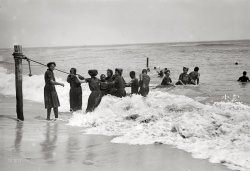
- Whirly Gig: 1921
- ... I wouldn't mind that style of suit for splashing in the ocean or sitting in the hot tub.
Sizing - it's all a scam For ... Posted by Dave - 08/19/2012 - 5:03pm -
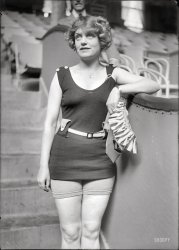
- Splash: 1905
- ... York, circa 1905. "Surf bathing." Splashing around in the ocean -- the latest fad. 8x10 inch glass negative, Detroit Publishing Co. ... Posted by Dave - 08/05/2012 - 1:41pm -
![Splash: 1905 Coney Island, New York, circa 1905. "Surf bathing." Splashing around in the ocean -- the latest fad. 8x10 inch glass negative, Detroit Publishing Co. View full size.
ObservationMostly Women. Hubba Hubba!
24 Hour FitnessThis guy is ripped for 1905!
And what's that on his wrist, looks like one of those wide 1960's watch bands.
[He's also seen here. - Dave]
Cookie cutter swimsuitsThat old adage "You are each unique" (just like everybody else) really shows up here. How monotonous the beachwear and the hairstyles were. With all the similar girls holding the rope, it reminds me of those cut-out paperdolls which are all connected by the hands, which they show in many movies but which I have never seen or created in real life. Have fun kids, in 106 years we will all be dead.
Outstanding The clarity of this photo is amazing. I look at the faces and almost expect them to start speaking.
ConeheadBehind the two women in the foreground, is that a woman wearing a hat resembling a lamp shade?
If I Could Turn Back TimeI would do everything in my power to date the doll holding the sunhat looking at the camera.
I could be my own Grandpa!
SweetI love the way the splash is caught right behind the two laughing girls.
Why We Love These TimesHis dreams were of a paradise that is only because it has always been. The waves of the surf will breathe theirs lives as the Earth's heartbeat and in each rush of in or out is rebirth. He was dreaming nothing that has not been already dreamed by the sage as well as the student. The truth of the overlying immutable is in the experience of these things that hold us with that immutability. Reality is like the palms of the Creator holding each & everyone of us: at the back, by the head, in the guts & by the groin. Reality is not a thought at this level so we must comprehend the essence of the concentration of respiration to understand & then better experience the reality; this respiration, because of it very nature of repetitive concentration becomes the object that always has wear & tear. Not to be DIY or Home Depot crazy, but a little rehab & fix & re-fix is called for at every turn. He knew that the wave was the wear and that the wear was the fun. Go to the beach & go to Home Depot: fix or re-fix that broken thing. Attempt the repair for it is good & for everyone & everything, request the ease of the waves of the sea.
Perfect Picture for a day with a heat index over 105. More of the same, please.
On the RopesIn many of these photographs there is a rope or a number of ropes going from the shore out into the water. I've never seen these in real life. What is their purpose?
[To hold onto. - Dave]
This guy is ripped for 1905??People had muscles in 1905. People worked in 1905. In fact I would suspect that a young man was more likely to be in good physical shape in 1905 because there were so many more manual labor jobs. We look at these old pictures and the scenes look so foreign to us that sometimes we forget these are real people just like us, with the same desires and the same problems.
Revenge of the swimsuit clonesContributing to the uniformity of the swim suits is that probably most are wearing rentals. See the two young men in the foreground with "BALMERS" across their chests. Balmer's Bathing Pavilion rented lockers and suits and provided showers as well as the rope guides. They also appear to have controlled at least a chunk of beach access.
Effective UV Protection Without ChemicalsI predict a big comeback for wool "beach stockings" next summer.
Strapping guyYes you are right about that wrist band on the muscle man vintagetv. In Dave's other photo it really looks like a watch band with two straps and buckles. Wonder if he lifted weights in the days before instructions and trainers and developed some carpal tunnel. Maybe that's what they used before velcro wraps.
(The Gallery, Coney Island, DPC, Swimming)](https://www.shorpy.com/files/images/4a21416a.thumbnail.jpg)
- Smoke on the Water: 1905
- ... and ersatz dog doo included) would be zipping across the ocean at unforeseen speeds to deliver their treasures to unemployed Americans. ... Posted by Dave - 08/02/2012 - 7:42pm -
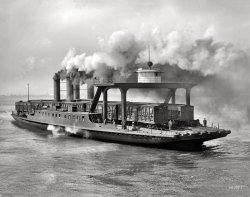
- The Bathing Hour: 1910
- ... I notice that there is a long line of pilings out into the ocean. It looks like the remains of one of the docks that might have been ... As Burt Lancaster said in "Atlantic City," "The Atlantic Ocean was really something in those days."
The focus of this picture ... Posted by Dave - 08/14/2012 - 2:10pm -
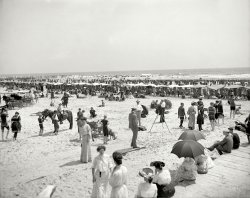
- A Place in the Sun: 1910
- ... Blown Away The young woman on the far left, just at the ocean's edge, looks as though she was just blown over by a tremendous blast of ... Posted by Dave - 12/18/2014 - 5:10pm -
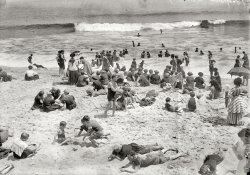
- Playtime: 1936
- ... of my babysitter's house and we kids called it the "ant ocean" and had a great time playing in it. Later, a big puddle that formed in a ... Posted by Dave - 07/18/2011 - 10:47am -
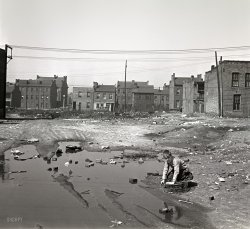
- Best Beer in Town: 1937
- ... I remember toy white seals (the kind that frolic in the ocean) which were tied around the bottles of Carstair's White Seal liquor and ... Posted by Dave - 08/11/2012 - 11:50am -
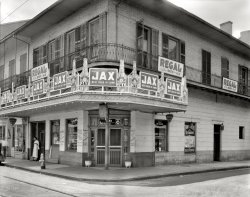
- Nantasket Beach: 1905
- ... fine expanse of gray sand, several miles long, between the ocean and the harbor, beaten by a light surf, and affording opportunity for ... Posted by Dave - 08/02/2012 - 7:43pm -
![Nantasket Beach: 1905 Nantasket Beach, Massachusetts, circa 1905. "Atlantic House and surf bathers." 8x10 inch glass negative, Detroit Publishing Company. View full size.
I love the beach scenes butAll I can think of is the uncomfortable ride home with sand in my bathing suits. I can't imagine the level of discomfort these people felt. I do love seeing people relaxing and enjoying themselves though.
Great HotelI know nothing about the hotel resort on the hill but if it's like any of the other hotels we've seen pictures on Shorpy of, I can guess it was probably destroyed in a fiery disaster.
Surf NantasketFifty or so years after this photo was taken, Boston's iconic DJ Arnie Ginsburg would be hosting record hops at the Surf Nantasket. Arnie's now retired to the coast of Maine. Boston folks still remember Arnie at the Surf Nantasket.
Atlantic HouseThe name of the hotel is in the caption -- Atlantic House. And yes, it burned to the ground, in January 1927. It was built in 1877 by John Damon and later enlarged to about 175 rooms. Most of the site is now occupied by the Atlantic Hill Condominiums.
Looks Like SandDefinitely sand on the left. Possibly Easter Sunday.
1879 EngravingAtlantic House on the left. Click to enlarge.
Skinny Dipper!Well, can't tell for sure; maybe that kid has on shorts, but considering the usual attire of the period, even that'd be pretty darn skinny!
[He is shockingly shirtless. Avert your gaze, ladies. - Dave]
My New WallpaperI think this might be my favorite beach shot to date. There's so much to love. The grand hotel, the beach houses, the Edwardian attire, the couple holding hands in the surf, the little kids wading.
Great Hotel DestroyedIn the late 19th century, The Atlantic House was the most famous summer hotel in New England due to its many and varied notable guests. Sarah Bernhardt, Wallis Simpson, President William McKinley and opera star Enrico Caruso, who gave two performances here, all enjoyed the fine accommodations the Atlantic House offered. Conveniences for guests included stairs directly to the beach and bath houses directly on the beach. The 175 room hotel burned to the ground during a blizzard on January 7, 1927.
I was just at this beachI was just at this beach last weekend. Aside from the attire and the buildings, it looks much the same. It's known for its dramatic variation between high and low tides. At low tide (depicted here) the beach is at least a quarter-mile wide; at high tide everyone is crowded up against the seawall just beyond the right edge of the frame here. On the other side of that (and the main road) would have been the famous Paragon Park.
Sea Bathing Absolutely Safe
How to See Boston: A Trustworthy Guide Book, 1895.
Boston Harbor
Nantasket Beach is reached from Hull by the steamboat crossing Hingham Bay and ascending the serpentine Weir River; or by a railway, running along the sea-bounds. It is a fine expanse of gray sand, several miles long, between the ocean and the harbor, beaten by a light surf, and affording opportunity for safe bathing. Above the high-tide line are groups of hotels, restaurants, chowder-houses, and bathing-houses, where Anglo-Saxon-Celtic-Latin-Slav Boston sends tens of thousands of her citizens on torrid summer days. It is a grand place for "a good time" in a democratic way.
United States Investor, June 28, 1913.
Atlantic House
Nantasket Beach, Mass.
One Hour from Boston by Boat or Train.
Rates: $5 per day and upwards
One Hundred Feet Above Sea Level.
Sea Bathing Absolutely Safe.
Address Linfield D. Damon, Manager
CanoeWonder how the canoe would handle the small surf? Interesting choice of seaside watercraft.
The Shorpy Curse!Another Grand Building destroyed by fire!
(The Gallery, DPC, Swimming)](https://www.shorpy.com/files/images/4a12853a.thumbnail.jpg)
- Playland: 1934
- ... interesting look at San Francisco car culture circa 1934. "Ocean Beach Playland -- Red Bug and Cliff House on Great Highway." With a ... House. To sit next to the windows and look out over the ocean without seeing anything else but water was scary and fascinating at the ... Posted by Dave - 11/17/2015 - 2:17pm -
![Playland: 1934 An interesting look at San Francisco car culture circa 1934. "Ocean Beach Playland -- Red Bug and Cliff House on Great Highway." With a billboard advertising Topsy's Roost, a dancehall and fried-chicken emporium just out of frame to the right. 5x7 negative, formerly of the Wyland Stanley collection. View full size.
A TrunkThe two cars left front show why we call the compartment in the back of the car a "Trunk". It was just a natural migration from an add on to a part of the car.
But I still haven't figured out why the British call it a "Boot"...
Scary MasonryThe scaffolding on the hillside was a skeleton that would support fake rocks being constructed out of cement or some similar material. I believe these were added to control erosion of the hillside as a project of the CCC (Civilian Conservation Corps). In later years, as they began to deteriorate and holes opened in them, the fake rocks made a nice clubhouse for illicit teen activities. The rocks were an eyesore and a safety hazard when they were finally removed sometime in the '70s.
WaterfallActually, the piping visible at right in the photo once fed an artificial waterfall that flowed downhill alongside the mini-windmill.
The attached 1927 photo from the SF Public Library shows the waterfall in its free-flowing glory.
Also, National Park Service did indeed remove several large, hollow fake rocks along the cliff face in the late 1970s. I used to patrol there for the Park Service, and one never knew what they were about to encounter when they entered the intensely creepy interiors.
Boot-Trunk, Bonnet-HoodOur British cousins decided early on to define the various ends of a motor vehicle analogous to human clothing of the day. Hence "bonnet" became the "top" (front) and "boot" became the bottom (rear).
Being far more practical and much less flowery we Americans call ours the "hood" (over the engine, at least for most cars) and "trunk" (self-defining).
The Brits also got the driver's position on the wrong side but that's a whole 'nother discussion.
Scaffolding to build the faux rock facadeI've climbed these cliffs a lot. The fake rocks are still there.
https://goo.gl/maps/vC5Jtj2ikKB2
I'm pretty sure that was a workmen's scaffolding to build them.
\
The closer cliff has been covered with ferro-cement and the pipes on the right seem to be connected to some sort of water feature that is still visible today as
pools, cascades, and fonts when it rains.
By 1938 the whole area was commandeered by the Coastal Command and next to the parapet at the top there still stands an OP pillbox.
I'll pass on the half fried chicken. I want my chicken fried completely.
Seal Rocks IslandThe building next to the sign in Shorpys picture is very similar to the one in the attached picture.
[There was no picture attached, but the building at the left edge is the most recent Cliff House, built in 1909 and today restored to its original appearance. -tterrace]
ROAD TRIP!To the Cliff House of the 1970s. I want the crab salad, an order of onion rings, and two of the tequila sunrises.
Lasergirlnm is buying. Thanks!!!
Boots and allA boot was a term used for a luggage compartment on a stage coach so it looks as though the English usage was just a continuation of the term from horse drawn to motorised. I suspect that an English person from the late 19th/early 20th centuries would think of a trunk as something to go in the boot.
StyleNowadays we hear people say that cars all look the same. After looking at this picture, cars today all have like styling just as the cars in this picture do. Just as most four door, two door and hatch type models today share like design, there's three distinct styles of cars in this photo that are all very similar too.
Cliff House!When I lived in the Santa Clara Valley in the 70s, one of our favorite special night-out places to go was Cliff House. To sit next to the windows and look out over the ocean without seeing anything else but water was scary and fascinating at the same time. They had a crab salad on the menu that took up a seashell-shaped bowl that was the size of a lavatory! And they had THE best tequila sunrises ever at Sunday brunch. Sometimes I wish I could go back to those days.
My grandfather used to work at Topsy's Roost. He was a sous chef there until opening up his own restaurants. That was a wild place. People would sit in their "roosts" and then slide down onto the dance floor to dance away the night.
Some great images and story about the place here.
Cruising StripNote how there are four cars making U-turns here to head back southward on the Great Highway. Either they were looking for parking at Playland or they were out enjoying the weekend cruising strip along the beach.
(The Gallery, Cars, Trucks, Buses, San Francisco, W. Stanley)](https://www.shorpy.com/files/images/SHORPY-776.thumbnail.jpg)
- Night Lights: 1905
- ... what was the water below this stage? Was it freshwater? Ocean water? Was it a fishpond or a dolphin tank?
A modern day Take on ... on the North side of Surf Avenue, across from the Atlantic Ocean so I imagine that the water used was from the ocean across the street. ... Posted by Dave - 12/19/2013 - 6:39pm -
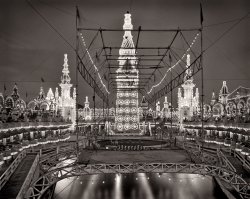
- Off Course: 1942
- ... For 34 scorching days and shivering nights they faced the ocean terrors - three men of a rubber raft four feet by eight, marooned in the ... Posted by Dave - 01/06/2014 - 3:03pm -
![Off Course: 1942 Circa 1942. "U.S. Navy -- inflatable raft." Just add water. View full size.
ratingThe Chief's rating is Pharmacist's Mate
WhatitzStrange symbol in the Chief's insignia. Anyone?
McHale's NavyThe lost original pilot.
Her DoCornrows back in '38?
[That's her hat, something along the lines of the one seen here. -tterrace]
Rating?Can anyone tell me what the rating of the CPO is? The 3rd class on the right is a radioman but I can not make out the chiefs. TIA
A Whole Different FeelA sincere thank you to Shorpyite sbhistory for identifying the photo. I certainly would not wish my previous little post to tarnish these three brave heros in any way.
Larry
Identity of sailorsI believe these three brave fellows are Harold Dixon, Tony Pastula and George Aldrich sitting in the actual raft they survived in for 35 days when they were forced to ditch their observation plane during the second World War. A great read written by Robert Trumbull called "The Raft" chronicles their amazing story.
[Bravo! Here's their photo from the article in the April 6, 1942 issue of LIFE magazine. -tterrace]
Training sessionSo we now know that prior to WW II it took a Chief (who's rating I can't see well enough to identify), a 3d Class Radioman, and a Seaman, to explain to a Commander how a life raft works. That's about right. It's nice to know that traditions have been kept up over the last 70 years.
[Edited 31Dec2013]
Maybe the caption should be changed to reflect the correct information. If I'd realized it was from 1942 I'd have been rather less flippant in my original comment.
Okay...now, how do we get it back in the bag?
Ah YesA late 1937 Goodyear Mark 4 first model raft. I may not be good at automobile identification, but I've got this raft thing down!
Based OnThe back story for this picture explains why Shorpy is such an educational site. Someone usually comments and helps us understand the what and the why or the where the photo was taken. Looking forward to more photo mysteries in 2014. As noted, "Always Something Interesting"
The Rest Of The StoryThe Raft
The courageous struggle of three naval airmen against the sea
Author: Robert Trumbull
When a plane carrying three airmen fails to return from its bombing mission on January 16, 1942, the U.S. Navy can afford only a brief search before giving the men up as dead.
For 34 scorching days and shivering nights they faced the ocean terrors - three men of a rubber raft four feet by eight, marooned in the middle of the mighty Pacific. They had no water...no food...no compass...no paddles. All they had was guts and a prayer. — Gigantic waves upset them. Man-eating sharks besieged them. The insane urge to cannibalize one another grew stronger by the day. But by feats of super endurance unsurpassed in sea history and by an unwavering faith in God they steered their way to the safety of an exotic South Sea isle.
Google Book Preview.
Seafarers FarkedFarked again!
(The Gallery, Boats & Bridges, Farked, WW2)](https://www.shorpy.com/files/images/SHORPY_05058u.thumbnail.jpg)
- Sand in Your Socks: 1905
- ... and then air travel.
Can you imagine going out in the ocean with your skirt going up above your head? Or trying to swim with the ... Posted by Dave - 08/24/2011 - 1:24pm -

- Tom 'n' Larry: 1941
- ... did fudge, and did it very well, about a block from the ocean on the corner of Seaside's main street.
Thanks for the embiggening, ... Posted by Dave - 02/06/2022 - 11:53am -
![Tom 'n' Larry: 1941 September 1941. "Sunbath on the beach. Seaside, Oregon." Enjoying "the panorama of the beach." Acetate negative by Russell Lee for the Farm Security Administration. View full size.
Naked Lunch.Click to embiggen.
Oddballs aboundSorry Dave but I can't figure out what you mean. All I see is the words Howling Dog on the front of the paperback.
But wow, the three leaning against the log ... mother-in-law along as third wheel? Real party animals, no? And the two sitting beneath the Sunfreze Ice Cream sign, checking the unlikely trio out, are almost as weird. The whole tableau strikes me as unsettlingly Hitchcockian. Something bad is going to happen to someone before long. But before it does, I would like a toasty sandwich and a rich, creamy milkshake from tom 'n' larry.
Classic Perry MasonMom is reading Erle Stanley Gardner’s "The Case of the Howling Dog."
“Soon … soon,” their hungry eyes would say.Hungry but biding their time, Tom and Larry seagull persevered in their quest, and eventually they were able to sample the mysterious box-lunch leftovers.
Moved to fudgeIn my day, mid '90s, Tom and Larry's did fudge, and did it very well, about a block from the ocean on the corner of Seaside's main street.
Thanks for the embiggening, DaveAt first I thought it was mother and daughter and the daughter’s guy, but it could be mother and son and the son’s girlfriend / wife. (The young’uns look like they’re sharing a screen, but of course they’re not, thank goodness.)
See? Wall!Looks like the original seawall is still there.
Knowledge is the wing wherewith we fly to heavenDave, how do you attach a photograph that can be embiggened? I've learned how to embed a Google Street view, attach a correctly sized photograph, and create a clicky link. But searching the Internet for "embiggen a photo" doesn't produce helpful results.
[Plain old HTML. Click "view source" to see how it's done. Uncheck the "List" box.- Dave]
Contemporary sign designAm I the only one who is startled by the "tom .n. larry" sign? I keep looking at it, trying to tell myself that this wouldn't impress someone looking for a restaurant with some flair in 2022. I can see Guy Fieri pointing up to it, the camera taking a close up, just as he goes in to meet the owners.
(The Gallery, Eateries & Bars, Russell Lee, Swimming)](https://www.shorpy.com/files/images/SHORPY-8c22557a.thumbnail.jpg)
- Lifeguard on Duty: 1905
- ... Jersey shore circa 1905. "On the beach at Ross' pavilion, Ocean Grove, N.J." Short of tuxes and ballgowns, it's hard to imagine being any ... Posted by Dave - 05/07/2014 - 10:00am -
![Lifeguard on Duty: 1905 The Jersey shore circa 1905. "On the beach at Ross' pavilion, Ocean Grove, N.J." Short of tuxes and ballgowns, it's hard to imagine being any more dressed up at the beach. (And cheer up, guy in the middle -- your problems are over by now.) 8x10 inch dry plate glass negative, Detroit Publishing Company. View full size.
Just CuriousDoes anybody know what the ropes are for?
[You grab onto them so you don't drown. - Dave]
yeah, i get that - but, in the sand? ...or does high tide bring the water up that far?
Casual workerTalk about laid back.
A perfect setting for the old Rodney Dangerfield jokein which a small boy runs up to a cop, pleading, "Officer, I'm lost! Can you help me find my parents?"
"Gee, I dunno, kid. There's so many places they could hide."
Anyone notice this?Looking at all the people on this beach you see them with nary anything around them on the sand. Mostly just themselves. Maybe a newspaper or two.
No towels, blankets, ginormous coolers filled with sodas, beer, or food, no boom boxes, no games, no toys, tote bags, floating toys, etc. So simple.
Beach was a breeze to clean up in the morning I bet.
Taking the sea airIn the days before modern drug treatments, the sea air was considered highly therapeutic. People with consumption (TB) for example, as well as other diseases were thought to benefit by breathing the salt-laden air. Hence the folks on the pier, and even inside the wide-open windows, are breathing in the therapeutic seaside breezes.
Insouciantyet alert, lifeguards still adopt that same pose a century later.
Blue LawsDo we think their beachwear was restrictive? The town was developed by the Camp Meeting Association, a Methodist group from Philadelphia. Before a 1981 court decision, they allowed no automobiles to be driven in the village on Sundays.
Ouch!That man in the suit and white hat is gonna need a chiropractor with that large rope tied around his waist!
It seems in 1905that people truly had no idea of the purpose of a beach, complete wool suits for men, 12 yards of material in dresses for women and crocheted tablecloths for shawls, some wearing what looks like bathing suits, others fully dressed plunked on the sand, and beyond, hundreds of fully clothed gawkers lining the shore, there seems no purpose to any of these shenanigans.
It's no useI find neither Zelig nor Waldo here.
OverdressedOr not, (almost) everybody seems to be having a good time. Why else would they be there?
Well, I never!One of them fancy photographer fellers with his no-good box.
Original Bumbo SeatNo one seems to have noticed the little tyke with the Buster Brown haircut in the lower left corner of the photo in front of the two women with shawls. The sand has been molded into a seat obviously by an adult to keep the child put. Ingenious.
Re: "Well, I never" ladyLooks like she's wearing her "Marcel" original Chapeau
The Scarlet LetterI know what an "A" stands for, after all we were forced to read the story in high school in the 60's, but what does the "R" stand for on the dude's chest?
[Perhaps the caption contains a clue. - Dave]
WarmI figure, after a winter with no central heating and coal smoke permeating the city, sitting at the beach in the fresh air and warmth felt pretty good, even in your wool suit.
The "guy in the middle"Do you think he's sad because he forgot his bathing suit?
(The Gallery, DPC, Swimming)](https://www.shorpy.com/files/images/SHORPY-4a12782a.thumbnail.jpg)
- Merry Dickey Christmas: 1912
- ... pennant reads "Georgetown" and the one on the left reads "Ocean City" (most likely Maryland).
They look happy here Much happier ... Posted by Dave - 12/10/2012 - 12:39pm -
![Merry Dickey Christmas: 1912 "Dickey Christmas tree." From around 1912 comes our sixth holiday greeting from the family of Washington, D.C., lawyer Raymond Dickey in what has become a Shorpy holiday tradition. National Photo glass negative. View full size.
PennantsInteresting display of pennants, and not collegiate ones. One seems to say "Germantown" so I'm guessing localities sold these as souvenirs. Wondering if these were a common thing to collect back then.
[The one on the right bears the name of Kallipolis Grotto No. 15, the lodge of a Masonic fraternal order. - Dave]
Whatever You DoDon't confuse the Dickeys with the Denbys.
Pennant raceI believe the pennant reads "Georgetown" and the one on the left reads "Ocean City" (most likely Maryland).
They look happy hereMuch happier than they do in the later photos. Wonder what happened between 1912 and 1914 to turn things sour.
That TreeJust big enough to be a tad too tall ---- perfect!
Senior DickThis is now the earliest of the six photos that extends from 1912 to 1923 in a sequence that is decidedly grim. It really is one of the saddest Shorpy experiences I've come across. Over the years, the mother becomes increasingly unhappy and insane, the children look more and more beaten down, and we Shorpy witnesses find solace in the tree and ornaments. I have no proof whatsoever, but I put the blame for this family misery wholly on the father. He with the cigar and the pocket flask has sucked the joy out of his home and stubbed out the merriness of the season in the lives of his wife and children.
[You'd think that after 10 years they (and National Photo) would have gotten the hang of it, but evidently not. Or maybe we are just seeing the outtakes. I look at these people, and the boy on the right, and think of James Thurber. -Dave]
CheeksThat little boy has such huge cheeks. They look swollen, almost like he had the mumps? Or bad adenoids. I do enjoy seeing pics of this family, even though they never look too happy (I realize the exposure times, and people were more serious in pics back then, usually).
[These are all flash pictures, so the exposure time was an eye-blink. -Dave]
Christmas DecorationsAmazing how little they have changed. The one to the left of Mr. Dickey's head is identical to ones I have.
It's OKCut a hole in the ceiling and be done with it.
ShoesSomeone buy that baby some new shoes!
Naughty or Nice? Hard to know...If you judged my own father's large family from the grim series of photographs spanning 100 years from about 1880, now in a trunk in my home, you might also think "Chekhov, Addams, and a dash of Dickens" (but truth is closer to Tennessee Williams or Erskine Caldwell), but my memory of those same people grimly photographed in gritty black and white in large gatherings over the years is consistently non-stop storytelling, laughter, and music.
So I don't really think it's fair to assume "family misery" from the series of family photographs we have here, much less blame Pa Dickey's cigars or flask.
I think it's simply that no one had come up with "Smile for the birdy" till somewhere around 1965.
Aside from that, it amazes me how consistent they were in getting trees that were just barely too tall.
My sister and I often enough laugh about our grim photographs wondering where Ma Barker and her boys have buried the bodies, but only because it seems remarkable such a happy and loving bunch could make so many decades of criminally grim photographs.
The GrottoI belong to Kallipolis Grotto. It is chartered in D.C. but meets in Maryland.
(The Gallery, Christmas, D.C., Natl Photo, The Dickeys)](https://www.shorpy.com/files/images/SHORPY_31618u.thumbnail.jpg)
- Shenango of Fairport: 1909
- ... be damaged. In stern-first launchings (more common on the ocean coasts) rudders were often fixed in position with temporary reinforcement ... Posted by Dave - 08/20/2012 - 2:05pm -
![Shenango of Fairport: 1909 Ecorse, Michigan, circa 1909. "Freighter Shenango on the ways." 8x10 inch dry plate glass negative, Detroit Publishing Company. View full size.
Is it the angle?From this view, the ship looks like it's missing a rudder!
[That's because there's no rudder! - Dave]
What yeardid the catastrophic scaffold collapse happen?
Ready to launchFrom the Buffalo Evening News, May 1, 1909.
LARGEST FREIGHTER ON THE GREAT LAKES.
The largest freighter on the lakes was scheduled for launching today at the Ecorse yards of the Great Lakes Engineering Works. It is the SHENANGO for the Shenango Steamship Company, a 607-footer. The new boat has a beam of 58 feet and a depth of 32 feet. Her cost completed will be $475,000. Capt. Henry Peterson will bring out the SHENANGO in June.
That scaffolding is wild!`No way you would catch ME up there!
Fearless duoIf I were one of the two guys standing there, I'd be afraid to cough!
Fearless duoIf I were one of these two guys, I'd be afraid to clear my throat!
HistoryApparently it was renamed five times and finally rested-in-peace in 1984.
http://www.sea-corps.com/retired.htm
A Familiar HullSome of the straight decked bulk freighters from this period have remained in service until the present day, since the freshwater of the Great Lakes is a lot easier on steel hulls than saltwater. The E M Ford, launched in 1898, was just decommissioned and scrapped in 2008. The Willis B. Boyer, formerly the Col. Schoonmaker, is moored at Toledo as a museum ship. It was launched in 1911, and taken out of service in 1980. The Boyer was also a product of the yards at Ecorse Michigan, and has a remarkably similar stern.
Up or under?I'd take the scaffolding rather than be under the ship on the port side any day of the week!
Great picLove this image, I used to work in a historical photo library refiling in their 200,000 print file print collection and this image is the exactly the sort of image that used and still does catch my eye. It has it all, fascinating.
Side LaunchingThe hydrodynamic loading in a side launch is huge. It is likely the rudder was routinely left ashore until after the big event or it would be damaged. In stern-first launchings (more common on the ocean coasts) rudders were often fixed in position with temporary reinforcement to help them survive the still-substantial impact with the water. There is a picture of this in the recent book "Live Yankees" by W. H. Bunting.
How Did They Do It?The collective historical knowledge of Shorpies never ceases to amaze me.
Okay, so the rudder wasn't fitted until after launch, but then how did they do it? With the ship in the water, fitting a big old rudder on her stern would present quite an engineering challenge.
[They did it by putting the rudder on before the launch. - Dave]
Fairport serendipityInteresting to see the side launch ways - would the ship be launched using hydraulic rams? The "Great Eastern" which was the largest ship in the world at the time (1850s) was launched into the Thames this way, but needed three or four attempts.
I was highly amused to see this lovely photo posted in mid August, as I have just attended the annual 3 day Fairport Shenango (or at least, shindig) in Cropredy near Oxford in the UK. This is a big music festival started by the band Fairport Convention, who named themselves after the North London house belonging to the father of a founder member. Cropredy village should really twin with Fairport Harbor!
Prop MadnessThis propeller looks to be made of steel not bronze. Each blade is attached to the hub separately and has a hole near the tip possible for a shackle. This makes it easer to change an ice damaged blade by the crew instead of being towed to a shipyard. My instructors would tell stories of changing the prop at dockside and having to carry any moveable object forward in order to get the stern high enough out of the water to get to the propeller nut.
Shipwrights weIt took me forever to count all the people in this one. Mr. Gangplank was obvious, but I see at least a dozen others.
(The Gallery, Boats & Bridges, DPC)](https://www.shorpy.com/files/images/4a18899a.thumbnail.jpg)
- By the Seashore: 1905
- Ocean Grove, New Jersey, circa 1905. "Ross's Pavilion and beach." Desperately ... Posted by Dave - 07/29/2010 - 3:37pm -
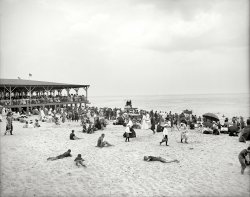
- Palm Beach: 1905
- ... Poinciana about a half mile east to the Breakers on the ocean. Guests could also choose to take the palm-lined "Ocean Walk."
The hotel closed around 1930 and was razed in 1936. It was the ... Posted by Dave - 07/27/2012 - 4:53pm -
![Palm Beach: 1905 Florida circa 1905. "The Palm Beach 'trolley.' " Early development in the Sunshine State. 8x10 inch dry plate glass negative, Detroit Publishing Co. View full size.
Flagler hotelsThis trolley led from the the gargantuan Hotel Royal Poinciana about a half mile east to the Breakers on the ocean. Guests could also choose to take the palm-lined "Ocean Walk."
The hotel closed around 1930 and was razed in 1936. It was the largest wooden structure in the world when it was built.
http://royalpoincianahotel.blogspot.com/
A quibbleis that the term "trolley" refers to the apparatus for picking up electrical power from an overhead wire, absent in this case.
[The word meant "cart." As in horse trolley. It eventually came to be applied to the apparatus drawing electrical current from overhead wires to power a trolley car. Strictly speaking, this conveyance is a horsecar. Which is why the caption puts the word trolley in quotes. - Dave]
JustificationAnother reason I visit Shorpy every day is to give myself a linguistic tuneup.
Trolleys = Go-kartsIn New Zealand (and probably other places) go-karts are "trolleys." There are annual "trolley races" all over. A friend is an organizer for one.
Flagler SystemThe trolley is owned by Henry Flagler's Florida East Coast Railroad. Flagler was the man most responsible for early real estate development and resort building in Florida, bringing all interested parties down there via his own railroad, which ran all the way to Key West, with ferry service to Havana.
HorsepowerWhatever it is, it gets around on 1 HP.
Old FloridaHaving grown up in South Miami, I'm loving this series.
Anyone who attended South Florida schools in the 1960s would know all about Henry Flagler and his railroads and hotels. If I'm ever offered a time machine, my first trip will be to South Florida and the Keys circa 1900. It's wall-to-wall concrete now even compared to when I was a kid, but the pristine, undeveloped wilderness of the area must have been stunning at the time.
(The Gallery, DPC, Florida, Horses, Streetcars)](https://www.shorpy.com/files/images/4a12557a.thumbnail.jpg)
- Stacked Decks: 1911
- ... in the 1930s, a generation later than these two fine ocean liners, the Long Beach-moored QM is the only ship remaining to suggest ... too. After all that, Jessop continued her career aboard ocean liners, apparently without further excitement but perhaps with a few ... Posted by Dave - 08/13/2012 - 7:27pm -
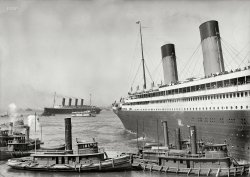
- The Plaza: 1912
- ... were being sold away -- all looking like a parts of an ocean liner run aground. I wish I had photographed the Palm Court - strewn ... Posted by Dave - 08/15/2012 - 2:40pm -
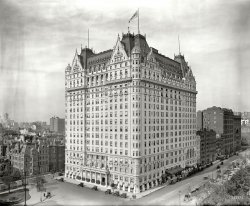
- Palm Beach: 1904
- ... type. I don't know that I would stick myself in the ocean if I couldn't swim.
The Newport of the South This picture was ... Posted by Dave - 08/13/2012 - 9:12pm -
![Palm Beach: 1904 Florida circa 1904. "Surf bathing at Palm Beach." 8x10 inch dry plate glass negative, Detroit Publishing Company. View full size.
Uh huhI didn't know they did Elvis wigs back then.
CostanzaWho's that short, stocky, slow-witted bald man in the foreground? No doubt looking for his blanket and clothes.
Let's Change The SubjectI think Dave wanted to forget snow as quickly as possible.
Water Wings Anyone?I am assuming that the people holding desperately to the rope are not the swimming type. I don't know that I would stick myself in the ocean if I couldn't swim.
The Newport of the SouthThis picture was taken during the short winter tourist season (January to mid-March) at the Breakers Hotel Beach.
Everyone in this photo would have been fabulously wealthy.
The Breakers stood at the other end of the trolley line (posted yesterday.)
http://royalpoincianahotel.blogspot.com/
Swim costume dragThe folks "holding desperately to the rope" appear all to be women. Long wool swimming costumes when wet were heavy. As you can see from the woman walking to the left of those on the rope, you can see the amount of drag she's contending with. Even a good swimmer would have a few problems staying afloat without the somewhat heavy surf.
I suspect, though, that they may be enjoying a sort of body-surfing, or as close as those heavy costumes might allow.
So VaneAnyone have a guess as to why there is a windmill on the pier?
Marine biologistThe sea was very angry that day, my friends!
Bring Back the Wool SuitReally, I think they're an improvement over today's more revealing styles, considering that generally the skimpier the suit the more likely the person who is wearing it should not be. No such eyesores with these streamlined wool models!
WhistlesFor when "Help! I'm drowning!" just isn't enough?
Seems many (most?) of our subject here are donning them but I'd never really noticed them before.
[Those are locker keys. - Dave]
Sensory recallI love how I can look at a moment in time captured more than 100 years ago and almost instantly imagine what that particular day felt like -- the wind, slightly overcast skys, salty air, and the sound of the surf. It's kind of comforting to get a sense of the permanence of things.
Aw, Gee Whiz!The guy in the foreground seems to be saying to himself, "Uncle Gomez told me there'd be sharks! Two hours freezing my butt and chasing my whig in the wind and no sharks! Now I gotta buy a new whig! Rats!"
[The next morning, Millard Fillmore washed up a mile away. - Dave]
(The Gallery, DPC, Florida, Swimming)](https://www.shorpy.com/files/images/4a11862a.thumbnail.jpg)
- Grand Atlantic: 1905
- ...
I Wonder Did these gorgeous buildings face the ocean?
Forget the Hotel I want a room in the annex.
No unsightly ... is on Virginia Ave., which is at a right angle to the ocean, so the front of the Hotel doesn't face the sea.
There is modern ... Posted by Dave - 08/13/2012 - 6:58pm -
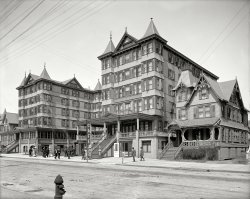
- Dr. Vedder: 1894
- ... center and may have flowed ... somewhere. A finger of the ocean was a very short distance away, if today's Treasury Street is still in ... Posted by Dave - 08/20/2012 - 10:22am -
![Dr. Vedder: 1894 St. Augustine, Florida, circa 1894. "Treasury Street." Dry plate glass negative by William Henry Jackson, Detroit Publishing Co. View full size.
Treasury StreetDoesn't the sign underneath the "Dr." say Bay Street - or is that alleyway Bay?
[The "alleyway" is Treasury Street -- the subject of the photo. - Dave]
Wilson's PrideOne of the great picket fences ever! Wonderful!
Great marketingGotta love that sign. Dr. Vedder will make you better.
Augustine, here I comeHave seen now several pictures of Augustine. I believe I should have been born there and not in in the wet-feet country Holland.
Clean alleyObviously, the posts at each end kept vehicles (horse-drawn at that time) from traveling down the alley. No back door deliveries on this segment of Treasury St. Also no horse manure on the cobblestones. If men didn't pee there (forgive me, I have lived in a third-world country), it was not a bad-smelling place.
The alley has a slight V-shape, so water drained to the center and may have flowed ... somewhere. A finger of the ocean was a very short distance away, if today's Treasury Street is still in its 1890s location.
Clean alleys are coming back in style. They are an important pedestrian-friendly component of "New Urbanism" neighborhoods. Other elements of New Urbanism include front porches, neighborhood stores, sidewalks, parks, common areas, and smaller lots -- much like an average middle-class 1890s neighborhood.
Dens of AlligatorsDr. John J. Vedder (1819-1899), seen here, was a wealthy retired dentist and business investor from Schenectady, New York, with a passion for the natural history and fauna of Florida. He transformed his residence into a private museum, Vedder's Genuine Curiosity Store, to house his displays of Florida's native species, and learned taxidermy to create his displays. His first cousin, Elihu Vedder, Jr., was the renowned American painter. Dr. Vedder eventually sold his museum to the St. Augustine Historical Society, its first home. Here is an 1886 advertisement for Dr. Vedder's museum.
AmazingThis is, by far, the most amazing photo I've seen on Shorpy yet. It has a time-machine quality to it; you can almost feel what it would have been like to stand there with the good doctor. The image also has a sense of movement - when you look at the gentleman in the distance at the other end of the alley, who is strolling down the street. I'm left wondering, though, what the sign leaning against Dr. Vedder's 1st floor window says.
["Oceanic Sun Fish." - Dave]
LoveThis is the kind of photo I get lost in. Wonderful. I love you Shorpy's.
Family member hereI am a great-great-great grandson of Dr. John Vedder. I have seen several photos of him but this is by far the clearest. There is a similar photograph in the Rollins College Archives. You can read all you care to know about the Vedder Museum here:
http://freepages.family.rootsweb.ancestry.com/~wabnoles/veddermuseum.htm...
Curlicues and flourishesIt's always fascinating to see how commercial signage styles change. One thing you would never expect to see any more is the decorative detail in the D, and that thingy dangling from the V.
A Great TownAn amazing photograph with the kind of clarity that glass plate negatives could give. Dr. Vedders' building was originally the Panton and Lesley office, built during the 1770s British period. They were the licensed Indian traders at the time of the Revolution. It is currently the site of the Hilton hotel, but the short wall in front is still there, retained as an historical artifact, as is Treasury Street itself, touted for years as the country's narrowest thouroughfare. Bay Street is now Castillo Drive, but is still commonly called the Bayfront. It's a great place to visit!
(The Gallery, DPC, Florida, W.H. Jackson)](https://www.shorpy.com/files/images/4a03634a.thumbnail.jpg)
- S.S. Olympic: 1911
- ... three, but not by a lot. Olympic was the world's largest ocean liner between the time she was launched and 1934 or so, when the Queen ... Posted by Dave - 07/18/2012 - 7:05pm -
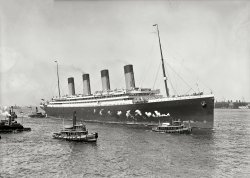
- Kitty Hawk: 1901
- ... a wide and endless beach, tremendous wind, a rough green ocean, and a small leaning shed. We were able to go up and touch the shed. It ... Posted by Dave - 12/13/2007 - 6:55pm -
